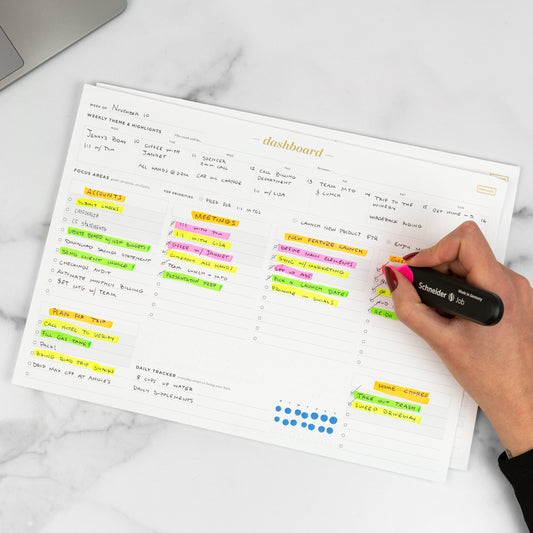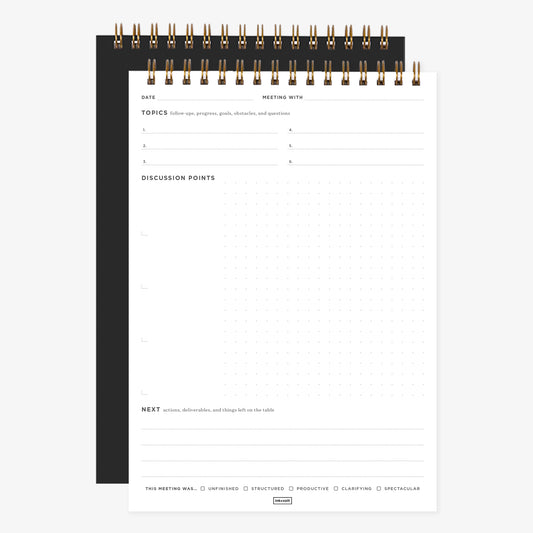Possibly the biggest eye-roll in our weekly schedules are mandatory, often unproductive business meetings.
When meetings are done right, participants leave feeling informed, involved, and prepared. But mastering that result each and every time can feel like firing shots in the dark… did we cover everything? Was the meeting too long? Shoot… did anyone take notes?
If you’re reading this blog, you’re likely someone who knows the true potential of a great meeting. Bringing your team together to get on the same page saves time and streamlines everyone’s efforts.
But when we pack too much into our meetings or if our meetings don’t have a clear focus or direction, we quickly lose the attention of participants, and exhaustion is contagious.
This happens in too many meetings. It’s why meetings have such a bad reputation. Business meetings should move your business forward; not just bring everyone together just to say you did. It is all about adding value for everyone involved.
Here is how you run a really productive meeting, every single time.
Every business meeting needs a business goal
No matter your industry, your team will always have various reasons to meet depending on projects, timelines, client needs, and company developments.
It is critical that any meeting you schedule has a reason for happening. And ideally, the reason should be something more concrete than “sharing status” or “giving an update”. Those things can usually be done over email — which saves a huge amount of time and makes meetings more about meaningful progress.
The International Institute for Facilitation and Change, experts in the design and execution of successful team sessions, has lots of advice on running a successful meeting. One strategy they share is to structure your meeting with the end goal in mind. In other words, work backwards from the result you need to have.
When you think about organizing a meeting, start by answering this:
“By the end of this meeting we will have…”
There are so many ways to finish that sentence, and knowing exactly which one you need will help give your meeting focus, which will help it to be productive and a good use of time.
Here are a few examples of ways you could finish that sentence:
- analyzed options for ____
- made a decision on ____
- narrowed down candidates for ____
- figured out next steps to take on ____
- decided who will work on ____
- made a plan for ____
If you can’t figure out what the end result of your meeting should be, it’s very possible that you don’t need to have a meeting — or that you aren’t ready to have a meeting yet. Once a project is at a stage where a meeting is needed, it will be clear what benefit you will gain from bringing people together to discuss it.
Once you’ve chosen the focus for your meeting, you’ll need to decide how long it should take to meet your goal.
The average person’s attention span is about 18 minutes
Consider Parkinson’s law, which has become something of a project management mantra:
“Work expands so as to fill the time available for its completion.”
Knowing that the average human attention span barely reaches 20 minutes suddenly makes it clear why the traditional 60-minute-long meeting tends to be so boring and unproductive.
When you’re scheduling a meeting, consider what you could get done with just 15 minutes. Depending on the type of meeting and the subject matter, carefully crafting your agenda could shrink your team’s meeting time from an hour down to 30 or even 15 minutes.
Don’t confuse a short meeting with an unproductive one. More time spent in a meeting does not equal more getting done. If you go in with a goal and clear expectations for meeting participants, you can do a lot in a small amount of time.
How to create a successful business meeting agenda
Delivered 2-3 days in advance, and re-sent the morning of the meeting, your meeting agenda should be written with the short time frame and necessary discussion points in mind. For regular meetings (like monthly department check-ins) you can create a template and simply drop in the specifics for each meeting, so that crafting the agenda doesn’t take too much of your time.
When sending out a meeting agenda, try keeping it no longer than 3-5 items and make sure it is skimmable. People rarely read dense, long emails, so your meeting agenda should look easy to read — that way, people actually will read it and prepare!
Each agenda item should have a title, short enough description that any reader can absorb and feel prepared to discuss, and an accountability assignment so those who will be called upon to speak or provide information are prepared to do so.
Not quite sure what makes a short-but-substantial business meeting agenda? Here’s an example from one of my recent meetings:
Marketing Team Meeting
September 4, 2018 | 2:00-2:30pm
- Review choices for web design contract. (Amelia + Heather)
- Choose three print options to present to client. (Amelia)
- Record necessary information (copy) to accompany client communication. (Heather)
- Outline next steps between now and next meeting. (Heather)
It is short, simple, and left the team with clear expectations and deliverables for what this meeting was about and what results were needed.
Easy ways to increase participation and reduce distraction at your next business meeting
Even the best teams struggle to keep meetings interesting all the time. By putting a little effort in, you can get huge returns on participation and engagement. Here are a few ways to shake up the stagnant energy and increase participation in your next meeting.
Ditch the laptops in favor of handwritten notes
Studies have shown that when you take notes on a laptop or other digital device, you’re less likely to remember what you recorded later on. (Who hasn’t done a little secret emailing or Facebooking during a long meeting? Laptops breed distraction, and good meetings have focused participants.)
Plus, a laptop screen acts as a literal wall between you and the other people at the table — when you remove them, the meeting suddenly feels more open and collaborative.
Designate one person to take notes on a laptop for the group, who will send out their meeting minutes to the whole group afterwards. Encourage everyone else to take their own notes on paper.
Start with an icebreaker, like a personal/professional roundtable
Give each person 30 seconds — use an actual timer — to share what they’re up to personally and professionally. Some folks may be nervous about sharing bits of their personal life at first, but sharing something as simple as, “I took a hike with my dog this weekend”, followed with “I’m only 3 hours away from finishing the 98-page technical edit” brings your team closer together by seeing each other as people.
It also helps to get everyone participating in the meeting later. For timid participants, once they have spoken up one time (even just in an ice breaker), it makes it easier for them to contribute again later, rather than just keeping quiet for the entire meeting.
Reduce over-talking and awkward silences with a speaking ball
Have one of those stress-reliever balls sitting at your desk? Bring it to your next meeting and implement a rule that only the person holding the ball can speak. When someone else wants to chime in, they have to make eye contact with the speaker or politely raise their hand so the speaker can throw them the speaking ball. The physical action of playing ball while discussing important topics keeps participants’ brains more engaged, while at the same time helping streamline communication.
Always follow up to make sure things get done
I can’t think of a single person who enjoys receiving meeting minutes, let alone reads them ever again. Why does this happen? Because most meeting minutes are sent out in an unreadable, totally un-useful state. They usually are too long, too scattered, or too hard to pull key information from.
However, good meeting notes are extremely valuable as a record of what was discussed and what next steps are needed. They should be as important a part of your meeting process as the agenda.
As the person who typically records meeting minutes, I’ve learned that there’s an art to disseminating the information recorded in a meeting into a valuable course of action for the recipients.
Here is what I have learned about writing and sharing great meeting notes that people will actually read and use:
- Start by eliminating what you can. Without spending too much time, reread the notes you took and determine if anything can be omitted entirely (for example: something that was discussed but isn’t pertinent to next steps). Next, organize the minutes into sections:
- Section 1: Need-to-Know Info. This should be like an executive summary — only include critical details (like the main points of the meeting discussion and/or any major changes everyone should be aware of) here. More detailed notes spanning the rest of the meeting can be listed later in the document, where they can be read by people who are interested/need the info.
- Section 2: Next Steps: Create a clear and concise task list with the upcoming actions, tasks, and accountability items for each member of the team, including due dates and necessary details. Make sure it is clear who is responsible for what — attach a name to each action item — as well as a date or time when the deliverable is expected. This section can also include any questions that came up during the meeting. Make a note of who will be researching the answer and when they will deliver it to the team.
- Section 3: Completed + Celebrated. Focusing too much on forward motion can cause a dip in morale. If we fail to acknowledge and celebrate the small wins along the way, the hiccups and setbacks will tear your team apart. Showcase any recently completed projects, major line items, or client deliverables that have gone well. If there’s a link or visual that can be shared, the parties responsible for completing the task may feel an extra boost of positivity for being highlighted in company communication.
- Section 4: Date of the Next Meeting. Even if your meetings are repeated on a regular or predictable basis, having a calendar invite link at the bottom of each email means that no one can ever miss a meeting on account of “not knowing” it was scheduled.
And remember, in every instance that you consider a meeting, always ask first:
Does this topic, project, or discussion warrant a meeting? Could a mass email, conference call, or quick trip to a couple desks do the trick just as well?
Meetings take time and energy. Make sure the task at hand is worth the investment.









